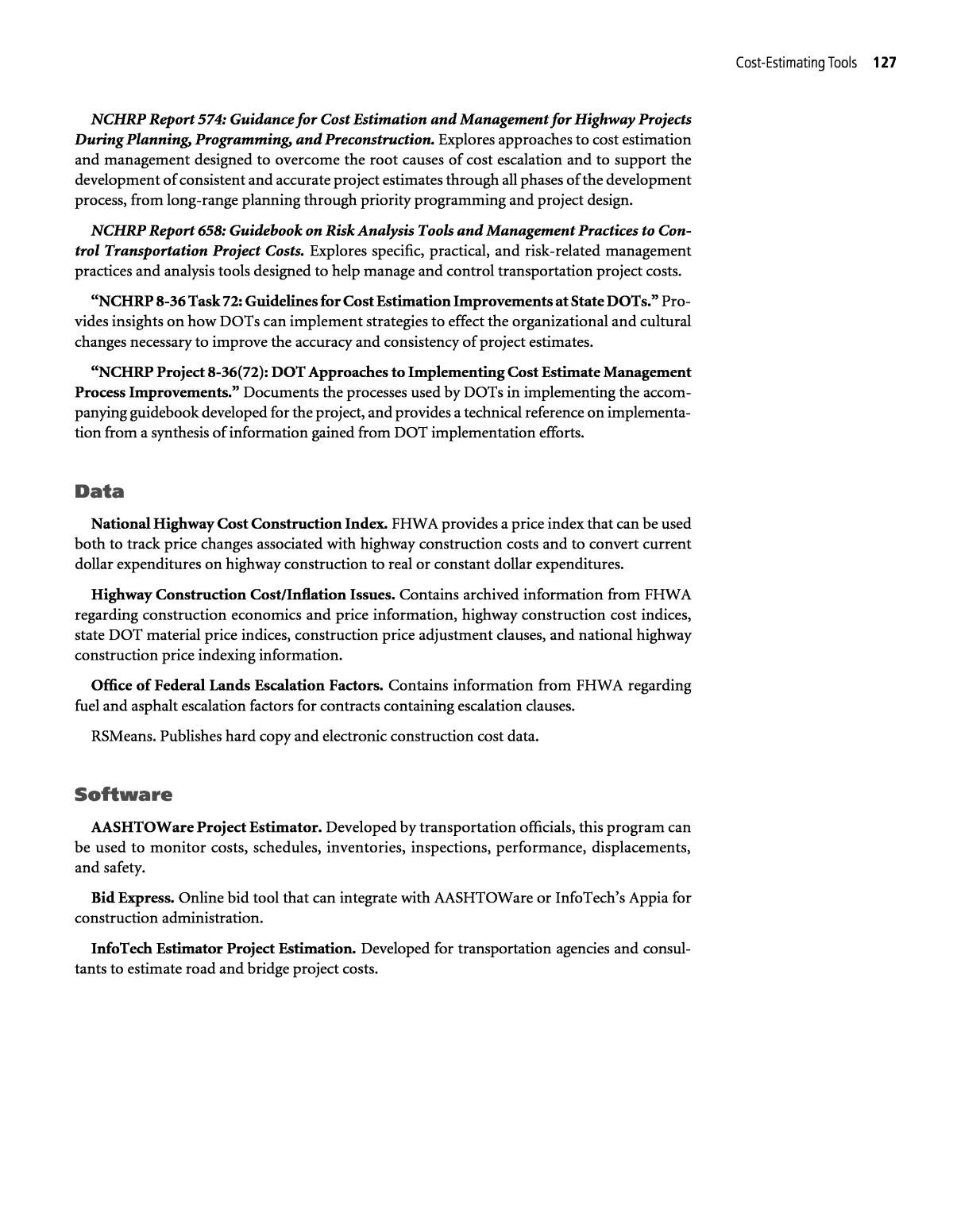

Below is the uncorrected machine-read text of this chapter, intended to provide our own search engines and external engines with highly rich, chapter-representative searchable text of each book. Because it is UNCORRECTED material, please consider the following text as a useful but insufficient proxy for the authoritative book pages.
126 In general, most DOTs have developed in-house cost databases and cost-estimating software or spreadsheets to reflect conditions and practices in their geographic region; however, a few guides and tools have been developed that are intended to be more universal. Tools AASHTO Practical Guide to Cost Estimating. Provides practical guidance that serves those charged with the development of DOT cost estimates and with managing the estimating process. AASHTO Technical Committee on Cost Estimating. Provides a focal point and working group to review, develop, and recommend AASHTOâs positions on cost estimating and risk- based estimating for transportation projects. NCHRP Report 625: Procedures Guide for Right-of-Way Cost Estimation and Cost Manage- ment. Builds on NCHRP Report 574 to provide a more in-depth analysis of the problems and practices of right-of-way cost estimating and cost management. U.S. Government Accountability Office Cost Estimating and Assessment Guide. Establishes a consistent methodology that is based on best practices and that can be used across the federal government for developing, managing, and evaluating capital program cost estimates. It pro- vides principles to guide assessment of the credibility of a programâs cost estimate for budget and decision-making purposes and the programâs status using earned value management (EVM). Major Project Program Cost Estimating Guidance. FHWA provides guidance for prepara- tion of a total program cost estimate for a major project. Cost and Oversight of Major Highway and Bridge Projects: Issues and Options. GAO identifies ways to enhance federal oversight of transportation projects that use federal funds, including improving cost performance of major projects and improving the quality of initial cost estimates. NCHRP Report 688: Determining Highway Maintenance Costs. Presents a practical, robust, and flexible process for determining an agencyâs full costs associated with performing highway maintenance. NCHRP Project 20-07(152), âProject Cost Estimating: A Synthesis of Highway Practice.â Provides a synthesis of state DOT project cost-estimating experience and presents information on effective ways to structure cost-estimating methodologies (link not available). NCHRP Project 20-07(274), âPrice Indexing in Transportation Construction Contracts.â Describes the current state of DOT practice in using price indexing or cost escalation clauses in construction contracts, and provides information for DOT staff making decisions about whether and how such clauses will be used. A P P E N D I X E Cost-Estimating Tools
Cost-Estimating Tools 127 NCHRP Report 574: Guidance for Cost Estimation and Management for Highway Projects During Planning, Programming, and Preconstruction. Explores approaches to cost estimation and management designed to overcome the root causes of cost escalation and to support the development of consistent and accurate project estimates through all phases of the development process, from long-range planning through priority programming and project design. NCHRP Report 658: Guidebook on Risk Analysis Tools and Management Practices to Con- trol Transportation Project Costs. Explores specific, practical, and risk-related management practices and analysis tools designed to help manage and control transportation project costs. âNCHRP 8-36 Task 72: Guidelines for Cost Estimation Improvements at State DOTs.â Pro- vides insights on how DOTs can implement strategies to effect the organizational and cultural changes necessary to improve the accuracy and consistency of project estimates. âNCHRP Project 8-36(72): DOT Approaches to Implementing Cost Estimate Management Process Improvements.â Documents the processes used by DOTs in implementing the accom- panying guidebook developed for the project, and provides a technical reference on implementa- tion from a synthesis of information gained from DOT implementation efforts. Data National Highway Cost Construction Index. FHWA provides a price index that can be used both to track price changes associated with highway construction costs and to convert current dollar expenditures on highway construction to real or constant dollar expenditures. Highway Construction Cost/Inflation Issues. Contains archived information from FHWA regarding construction economics and price information, highway construction cost indices, state DOT material price indices, construction price adjustment clauses, and national highway construction price indexing information. Office of Federal Lands Escalation Factors. Contains information from FHWA regarding fuel and asphalt escalation factors for contracts containing escalation clauses. RSMeans. Publishes hard copy and electronic construction cost data. Software AASHTOWare Project Estimator. Developed by transportation officials, this program can be used to monitor costs, schedules, inventories, inspections, performance, displacements, and safety. Bid Express. Online bid tool that can integrate with AASHTOWare or InfoTechâs Appia for construction administration. InfoTech Estimator Project Estimation. Developed for transportation agencies and consul- tants to estimate road and bridge project costs.
